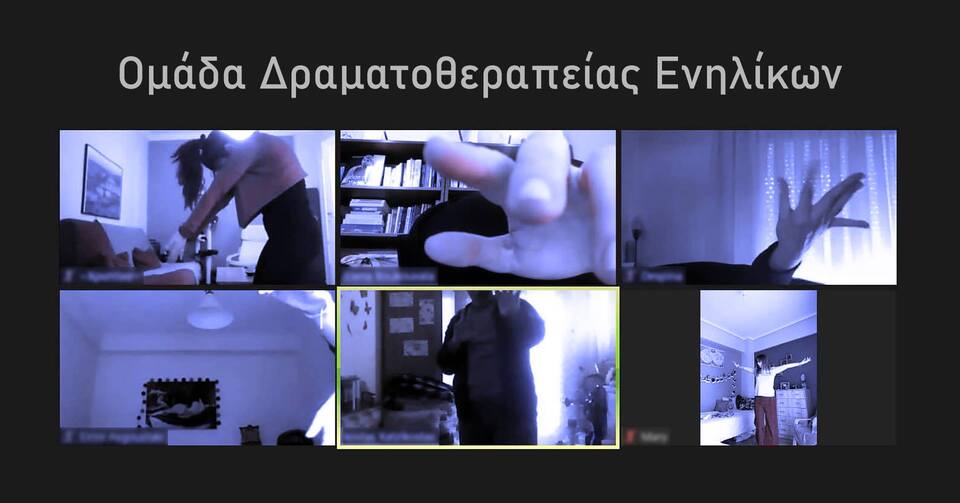Στις 7 Μαίου ξεκινά απο την Έλενα Μπουκουβάλα, online κλειστή ομάδα δραματοθεραπείας, με στόχους την προσωπική αναζήτηση, την συναισθηματική έκφραση, αλλά και τη γνωριμία με τη μέθοδο της Θεραπείας μέσω Δράματος και Κίνησης. Η ομάδα θα ενημερώνεται κάθε φορά από τις ανάγκες και σύμφωνα με τα ενδιαφέροντα των συμμετεχόντων της. Θα πραγματοποιείται κάθε Παρασκευή 18.00 – 19.30 και ο πρώτος κύκλος θα ολοκληρωθεί σε 15 συναντήσεις.
Οι πρώτες δύο συναντήσεις της ομάδας θα είναι ανοιχτές και θα δέχονται νέα μέλη. Στη συνέχεια η ομάδα θα είναι κλειστή. Μέσα από το παίξιμο ρόλων (role playing), αλλά και την προώθηση διαφορετικών μορφών και τρόπων κίνησης, την δραματοποίηση ιστοριών, την δημιουργική γραφή και την μουσική έκφραση θα δοθεί η δυνατότητα στους συμμετέχοντες να πειραματιστούν με εναλλακτικούς τρόπους συμπεριφοράς και αντιμετώπισης καταστάσεων της ζωής τους. Σε ένα μη-αντιπαραθετικό ψυχοθεραπευτικό πλαίσιο, βασιζόμενο στη γνώση ότι οι δυσκολίες μπορούν να αποκαλυφθούν μέσω μεταφορικών εννοιών, τα μέλη της ομάδας θα έχουν την ευκαιρία να αναβιώσουν προσωπικές τους εμπειρίες και να πειραματιστούν αναζητώντας καινούργιες λύσεις και δυνατότητες. Μέσα από την ασφάλεια που παρέχει η χρήση των τεχνών, θα μπορούν να εκφράσουν όλων των ειδών τα συναισθήματα και τις σκέψεις, με σκοπό να εξερευνήσουν και να εκφράσουν τα συναισθήματα τους, να αναπτύξουν την αυτοπεποίθηση τους, να γνωρίσουν σε βάθος τον εαυτό τους αλλά και να διευκολύνουν την επικοινωνία τους με άλλους ανθρώπους. Η ομάδα θα γίνει online, δίνοντας την δυνατότητα σε όλους τους συμμετέχοντες να δουλέψουν με ασφάλεια δημιουργικά και θεραπευτικά.Η ομάδα αυτή θα αποτελεί επίσης και μια ευκαιρία γνωριμίας με τη μέθοδο της Θεραπείας μέσω Δράματος και Κίνησης, για όποιον ενδιαφέρεται να παρακολουθήσει το μεταπτυχιακό εκπαιδευτικό πρόγραμμα Δραματοθεραπείας. Οι ημερομηνίες διεξαγωγής της ομάδας είναι: 7/5, 14/5, 21/5, 28/5, 4/6, 11/6, 18/6, 25/6, 2/7, 9/7, 16/7, 23/7, 30/7, 7/8, 14/8 και ώρα 18:00 – 19:30.
Το κόστος κάθε συνεδρίας είναι 20E (15E μειωμένο και για φοιτητές). Σε περίπτωση οικονομικών δυσκολιών επικοινωνήστε μαζί μας.
Απαιτείται κράτηση θέσης και θα προηγηθεί ατομική συνέντευξη με τους ενδιαφερόμενους. Δε χρειάζεται προηγούμενη εμπειρία στη μέθοδο της δραματοθεραπείας. Για περισσότερες πληροφορίες κι εγγραφές μπορείτε να επικοινωνήσετε με τη θεραπεύτρια Έλενα Μπουκουβάλα στο 694 7815524 και στο elenaboukouvala@gmail.com και με το Επίνειο 2314035212. Η Έλενα Μπουκουβάλα είναι Ψυχολόγος (Αριστοτέλειο Πανεπιστήμιο Θεσσαλονίκης), Δραματοθεραπεύτρια (ΜΑ Sesame University of London), Σύμβουλος Παιδιών και Νέων (ΜΑ University of Nottingham), είναι μέλος του εκπαιδευτικού προσωπικού του Επίνειου (Θεσσαλονίκη) και του East Side Institute (Νέα Υόρκη) και PhD ερευνήτρια στο Οpen University (Αγγλία). Δουλεύει από το 2004 ως θεραπεύτρια σε δημοτικά και γυμνάσια σχολεία, νοσοκομεία, προσφυγικούς καταυλισμούς σε άλλες κοινότητες καθώς και ιδιωτικά, έχοντας εξειδικευτεί στην κοινωνική ένταξη παιδιών και νέων. Έχει εκπαιδευτεί στην Ελλάδα, στην Αγγλία και στην Αμερική και έχει εργαστεί στην Ελλάδα, Αγγλία, Ρουμανία, Γερμανία, Δανία, Σερβία, Ουγγαρία, Αλγερία και στην Βηρυτό. Είναι εκπαιδεύτρια κίνησης Laban και Movement With Touch, όπως και συντονίστρια των θεραπευτικών ομάδων στο Μεταπτυχιακό Εκπαιδευτικό Πρόγραμμα Δραματοθεραπείας στο Επίνειο. Είναι ιδρύτρια του συνεδρίου Play Perform Learn Grow (www.pplg.org). Είναι επίσης μέλος του Βρετανικού Συλλόγου Δραματοθεραπευτών και του Ελληνικού Συλλόγου Ψυχολόγων.
